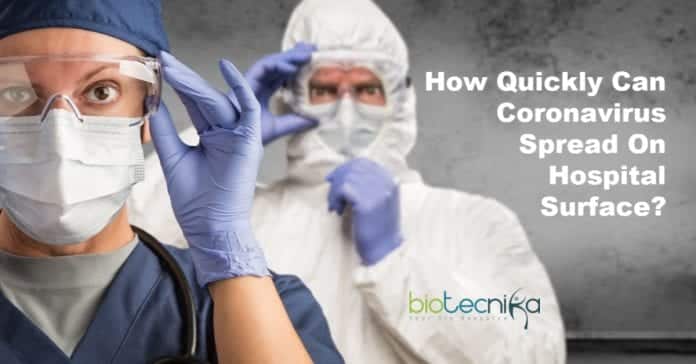Coronavirus Transmission: How quickly can coronavirus spread via hospital surface?
New research by College University London and Great Ormond Street Hospital (GOSH) has aimed to simulate how quickly SARS-CoV-2 (coronavirus), may spread throughout the surface in hospitals. The scientists didn’t use the SARS-CoV-2 virus due to safety concerns but used artificially replicated a portion of DNA from a plant-infecting virus, which can’t infect humans, then added it to a milliliter of water at a comparable concentration to SARS-CoV-2 copies found in the respiratory samples of infected patients.
Result:
In nearly half of all sites sampled throughout a ward, the viral DNA left on a hospital bed rail was found within 10 hours and for at least 5 days the virus remained on the surfaces. The research is released in the Journal of Hospital Infection as a letter.
Scientists placed the water having the DNA on the handrail in an isolation area – a room for higher-risk or infected people. Then they sampled 44 sites throughout a hospital ward over the next to 5 days. After 10 hours they found that the surrogate genetic material had spread to 41% of sites tested across the hospital ward including bed rails, children’s toys
and books in a play area, and door handles in a waiting room. After 3 days, this increased to 59% of sites, and on the 5 day it increased by 41%.The highest percentage of sites that tested positive for the surrogate originated from the immediate bedspace location – consisting of a nearby room with numerous other beds – and medical areas such as treatment spaces. 86% of sampled sites in clinical areas tested positive on day 3, and 60% of sampled sites in the immediate bedspace area tested positive on day 4.
The research made use of viral DNA in water – much sticky fluid such as mucus would likely spread more easily, whereas the virus – SARS-CoV-2 will likely be spread within bodily fluid such as cough droplets.
One caution to the research is that, while it demonstrates how rapidly a virus can spread if left on a surface, it can not figure out exactly how likely it is that an individual would be infected.
“Our research shows the vital role that surfaces play in the transmission of a virus and also how critical it is to adhere to good hand hygiene and cleaning. The surrogate genetic material was inoculated once to just one site and was spread via the touching of surfaces by staff, visitors, and patients. An individual with COVID-19 will shed the virus via coughing, touching surfaces, and sneezing on more than one site,” said Dr. Lena Ciric, UCL, a senior author of the study.
Author: Sruthi S
































